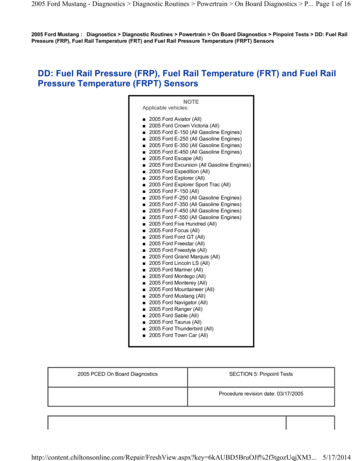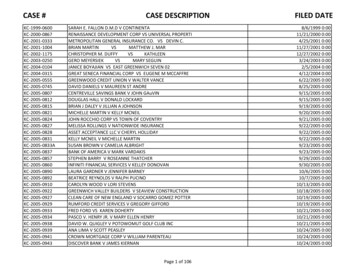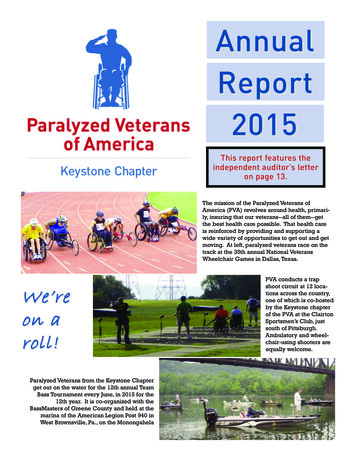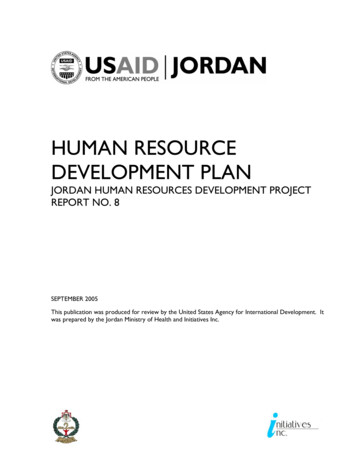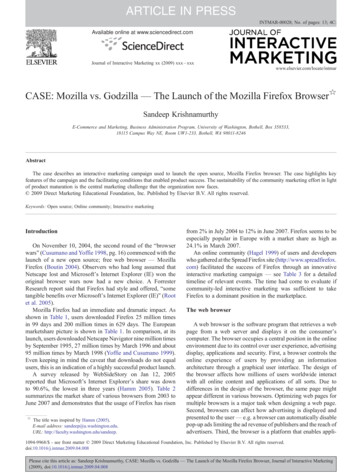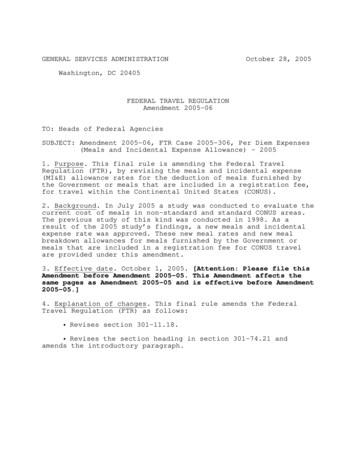
Transcription
T2005ANNUAL REPORTARRANT COUNTY PUBLIC HEALTH
Director’s MessageY“Without health, there is no happiness.”— Thomas JeffersonEssential Servicesof Public Health1. Monitor the health status ofthe community.2. Investigate and diagnosehealth problems and hazards.3. Inform and educate peopleregarding health issues.4. Mobilize partnerships to solvecommunity problems.5. Support policies and plans toachieve health goals.6. Enforce laws and regulationsto protect health and safety.7. Link people to neededpersonal health services.8. Ensure a skilled, competentpublic health workforce.9. Evaluate effectiveness,accessibility and quality ofhealth services.10. Research and apply innovativesolutions.ou might want to find out when the next major strategicplanning session is scheduled for Tarrant County PublicHealth (TCPH).The first time we completed our plan with input from you itwas Sept. 10, 2001. In 2005, we conducted another majorreview of our plan. This time we started with staff input. On themorning of Aug. 29, 30 staff representatives started working onthe draft. By noon at least five of us had been called out of themeeting, and by 2 p.m. a general announcement was made thatthe Emergency Operations Center for Tarrant County was openand our Department Operations Center was opening inpreparation for Katrina evacuees. All necessary staff in theincident command structure were needed to report for duty. Therest of the staff continued with the business at hand, which wascompleting the draft strategic plan document.And indeed that is how the next six weeks proceeded. Moreand more of us became involved in the tremendous county-wideeffort to provide services for not only Katrina but also Ritaevacuees. The rest of us maintained a constant level of servicefor the communities comprising Tarrant County and the region.It is now many months later, and we are working diligently onour after-action items, as are many of you. But we are alsoworking on our strategic plan. Our completed plan embracesthe nationally accepted 10 essential services of a public healthdepartment as goals, and it identifies six priorities for thedepartment. The plan takes these priorities and assignsmeasurable objectives and a task analysis to each so that we haveresponsible people to assure that we do what we say we aregoing to do. Our priorities include 1) monitoring thecommunity health status 2) promoting healthful living 3)providing preventive health services 4) responding to publichealth threats and emergencies 5) reducing the burden of healthdisparities and chronic diseases and 6) applying best practices toimprove public health services.Please review our priorities, and if you have a question aboutthem or a suggestion for an additional one, please e-mail me atlkbrewer@tarrantcounty.com. This is a working document andwe value your input. One of our biggest challenges continues tobe maintaining the balance between being responsive to theurgent needs of the community while never losing sight of theongoing and long-term needs of the community.The Best in Health,Lou Kelley Brewer, RN, MPHDirector,Tarrant County Public Health2
New leadership staffSANTOS NAVARRETTE, JR., MBA, MASantos, our newest Associate Director, assumed his duties in late July. Hisresponsibilities include oversight of Adult Health Services, HIV Administration, TBElimination, Environmental Health and Public Health’s Information Technology staff.Born in Knox City, Texas, and raised in Rule, Texas, Santos is married with threeadult sons. He spent the bulk of his career in the U.S. Air Force, where he served as aspecialist in human performance training in the field of aerospace physiology. Hefurthered his education during his service, gaining a Bachelor’s in psychology, an MBAin health care administration, and a Master’s in human resource management.Though his career took him all over the world, he came back to Texas upon leavingthe military after 28 years.Most recently, he was the Assistant Health Director for the city of Laredo. As far ashis new duties, he’s very impressed with the TCPH staff. “I’m still learning how thingswork here, but I’m the type who won’t try to fix something that isn’t broken. Ibelieve if you take care of your people and give them the tools they need, themission will be accomplished.” ANN SALYER-CALDWELL, MPH, RD, LDAnn is a classic example of the breadth, skill and expertise that can be found in thepublic health field. She earned a Master’s of Public Health degree and a Bachelor ofScience in dietetics. She has worked in public health for 26 years, 24 with TarrantCounty. Ann began her career as the director of the WIC program, and in 1997 waspromoted to division manager with Community Health Promotion. She continued inthis position for eight years before accepting her current promotion to AssociateDirector of Community Health Promotion. Ann is married and has two teenage sons.In her new position, Ann directs all activities and staff related to public healthpreparedness, immunizations at all health centers, child and family health initiatives,chronic disease, nutrition assessment and education, and the administration of theWIC program.Ann’s expertise is complemented by her position as a captain in the U.S. NavyReserve where she currently serves as the Health Services Department Head for theOperational Health Support Unit Dallas. She has served in the Reserve since 1985.Additionally, Ann serves on the following boards and commissions: Tarrant CountyInfant Mortality Task Force steering committee; Tarrant County College, Dietetic Technician AdvisoryCommittee; North Texas Adult Immunization Coalition (co-chair); City MatCH (board member); TexasAssociation of Local WIC Directors (committee chair); and as a consultant with the Department of Defensefor WIC Overseas Development. Provider relationsTarrant County Public Health is in constant communication with various health care providers in themedical community. We host a monthly infectious disease roundtable with representatives from localhospitals. Our health authority provides timely information to all physicians through a monthly “PublicHealth Notes” column in the Tarrant County Physician magazine.Interaction is also maintained electronically. Local and regional health data and statistics are available toproviders through several Web sites including the TCPH Web site (http://health.tarrantcounty.com), a Website dedicated to infectious diseases, including bioterrorism agents (http://hidport.talho.org/hidport/), and asite developed by the Southwest Center for Advanced Public Health Practice (http://www.texasapc.net).3
A big thanks for your help during Hurricanes Katrina and RitaTo all those employees of Tarrant County Public Health who rose to the challenge when ourcommunity needed us during the Katrina and Rita response effort.Adam AbshariAdeola JaiyeolaAlbert RoyAlicia CancholaAllen ApplegateAlma McCarthyAmber SeastrunkAmy GormanAndrea MartinAngie BishopAngie SandovalAnita ColbertAnn Salyer-CaldwellAnna ValenciaAnnette MorrisAracelia CondeArchie HuntBarbara DevineyBeverly KarnesBridget HughesCarol Lee HamiltonCarolyn FordChristine LovingCindy McLeanCrystal DrapkinDawn NeedhamDebbie GreeverDebra MickensDebra RodriguezDonald FisherDonna WilliamsDot EssexDouglas FabioElvia DelgadoElvin AdamsEmily ParksEula KingEve RoussinFran KirkleyFran MillerGary RothbarthGerry DrewyerGloria BarredaGregory ReedHelen WalkerIdalia AragonJennifer SelfJennifer StewartJennifer ThomasJudy JonesJudy MartinezKaren KennedyKaren MarshallKeisha LeathermanKelly TaylorKim DieterichLayne WalkerLee SewellLeslie BrackenLindie GibbinsLisa BarberLiz JoumaaLou BrewerLouise SladeLucille ValdezLucy MartinezMargie DrakeMaria De La TorreMaria VillegasMerilyn SpanMichelle DunsmoreMichelle MarkhamMitzie JohnsonMonica TiptonNancy DomenechNaquita WhiteNicolette JanoskiNikki PadillaPat DunnamPauline LodriguePeggy WittiePrincella MarshRick WorkmanRonda AbendscheinRose BennettRyan WersteinSandra ManningSandy AndrewsSandy JarvisSantos Navarrette, Jr.Sondra WhiteleySonia Nobles WilsonSuzanne BordeSylvia DimasTerri PhillipsTerry LaFonVanassa JosephVeronica YbarraVictoria GreerWilliam BlankenshipYolanda CortezYvonne Florez“My role in ourhurricane response wasan honor and aprivilege.”– Michelle Dunsmore,EmergencyPreparednessNurse Coordinator Hurricanes make landfall in TexasTarrant County Public Health employeesanswered the call to assist with incoming hurricaneevacuees not once, but twice; not for a few hours,but for many weeks; not just from 9 to 5 Mondaythrough Friday, but 24 hours a day, seven days aweek, including the Labor Day weekend. Weprovided medical system leadership in setting upscreening and triage and shelter assessments toprevent any communicable disease outbreaks andto promote healthy people and environments.There were no disease outbreaks, and we providedimmunizations to evacuees and deployed firstresponders. We sorted and delivered donatedmedications and consulted with volunteers andshelter managers day and night regarding healthquestions and concerns. Daily reports wereprepared for the Texas Department of State HealthTCPH’s Emergency Preparedness Coordinator Gregory ReedServices, the Health Resources and Servicesprovides health information during an inspection of one of theAdministration, the Centers for Disease Controlshelters set up to receive hurricane evacuees.and Prevention, and elected officials. TCPHprovided services to at least 41 separate shelter locations, working across jurisdictional boundaries.On the volunteer front, we trained 100 new Medical Reserve Corps (MRC) volunteers one week into the4
event and scheduled them throughout the duration. The MRC is an organization of medical and nonmedical volunteers who receive training and participate in exercises to test the county’s emergencypreparedness. Katrina and Rita greatly increased enrollment in the MRC.TCPH epidemiology teams were on the forefront. Three epidemiology teams and three environmentalhealth teams went out daily to every shelter for the first week and stayed in touch thereafter with phonechecks until a shelter closed. We answered the call in the middle of the night to report to the EmergencyOperations Center (EOC) at 5 a.m.TCPH staff handled each situation with professionalism. On one occasion, we stepped out of whateverour after-hours activity might have been to calm a frantic shelter manager who called to find out if adischarged patient was contagious to the shelter group; we went back to the EOC at midnight of the fifthweek to plan for five buses and 36 cars of special-needs patients who were due to arrive in a few hours.Through it all, our staff kept our day-to-day services going, and we could not have done any of thiswithout the help of our partners and friends like JPS Health Network, Tarrant County Medical Society,Harris Methodist Fort Worth, Cook Childrens’, UNT Health Science Center, The Salvation Army, and theemployees of Fort Worth and Arlington.In the days and weeks after the initial crisis, we realized how much we had learned, how fortunate wewere to be part of such a dedicated county-wide effort, and how fervently we hoped this or anything like itwould never happen again. But when it does, we will be better prepared than we would have been withoutthis experience behind us. Syndromic Surveillance SystemThe syndromic surveillance system is a region-wide automated system that continuously monitorsmultiple sources of regional information for the early detection of disease outbreaks.The system was developed and implemented by theSouthwest Center for Advanced Public Health Practice and ourPublic Health epidemiology division in conjunction with theDFW Hospital Council and more than 35 hospitals across NorthCentral Texas. The system continuously monitors and analyzesregional hospital emergency department data and over-thecounter medicationsales. It sends alerts to“The (syndromic) system is one of the mostadvance-notice tools of its kind.”state and local health departments when activity in these critical– William Stephenshealth indicators exceeds normal levels.Manager,SouthwestCenter forThis system capability is critical to supporting regional effortsAdvancedPublicHealthPracticeto safeguard the public’s health in the event of bioterrorism or anatural outbreak such as pandemic influenza. It provides theearliest possible warnings of any unusual counts or the geographic spread of tell-tale signs and symptomsthat may be occurring under the radar. Pandemicflu“Pandemic influenza has public health andmedical community on guard against humanto-human transmission.”– Elvin Adams, MDTarrant County Health AuthorityPandemicinfluenza wouldarise from a new deadly strain of virus that could be easilytransmitted from person to person. The H5N1 strain ofavian flu has been looked upon as a potential candidatebecause it is a new flu virus that has been slowly spreadingaround the world. It has resulted in the deaths ofColorized electron micrograph of avian influenza A H5N1 viruses (seen in gold).Source: CDC Public Health Image Library.5
hundreds of millions of poultry. Fortunately, there have beenlow numbers of human cases, and human-to-humantransmission does not occur with the current genetic structureof this virus.The ever-enlarging interface between infected birds andpeople is increasing the possibility of genetic recombination of the bird flu virus with human flu viruses andthe emergence of a pandemic flu strain. In a flu pandemic, the health care system would be overwhelmed,schools would be closed, travel would be restricted and businesses would be adversely affected. Now is thetime for businesses, health care, and public health to lay plans to cope with the crisis pandemic flu wouldbring to our region.Tarrant County Public Health developed a pandemic flu plan a year ago and will be assisting businessesin developing their own customized pandemic plans.“Ten years ago we were not ready to test foravian influenza – today we are.”– Guy DixonManager, North Texas Regional Laboratory SNS exerciseMore than 200 TCPH employees andcommunity partners from local and stategovernment, law enforcement, volunteeragencies and the Medical Reserve Corpsparticipated in an exercise at the ResourceConnection in August. The exercise testedPublic Health’s capability to distributemedications from the Strategic NationalStockpile (SNS) to county residents. Othercapacities that were tested in the exerciseincluded command and control, security, clinicset-up, supply and equipment management,triage and communications.The stockpile of medications is maintainedby the Centers for Disease Control andHundreds of volunteers showed up at the Resource Connection as part ofPrevention and would be available in the eventthe simulated emergency exercise to test the SNS vaccine distributionof a disease outbreak that required medicatingcapabilities.largenumbers of people.“Public health information and educationmake a difference in our community everyThe result of the mock medication distribution was that moreday.”than 1,100 people were served in an hour. The data gathered in– Vanassa Josephthe exercise will serve as a baseline to improve the distributionSenior Public Information Officerprocess. The volunteers were from area schools, churches andother community groups. Gambusia minnows supplementsurveillance programIn 2005, mosquito larvae-eating minnows (Gambusia affinis)were provided to local governments to stock in specificmosquito infested areas. This project was unique in Texasbecause there had not previously been a coordinated effort toraise and distribute these minnows between local agencies.TCPH worked with the Department of State Health Servicesand Texas Parks and Wildlife to assure that proper stocking ofEnvironmental Health’s Gene Rattan feeds the latest weaponin the fight against West Nile virus—gambusia affinis minnows.6
the native minnow was accomplished. As part of the annual“Stocking gambusia minnows is a low-tech,training provided to mosquito surveillance participants, stafflow-cost tool to help combat mosquitoes.”were introduced to the legal means of minnow stocking and– David Jeffersonprovided with a reference guide (posted on the TCPH Web site).Manager, Environmental Health PromotionMinnows were supplied at no charge for stocking ongovernment rights of way and public property (not private property). Local governments that stockedminnows in 2005:ArlingtonHurstEdgecliff VillageBedfordMansfieldEulessBenbrookTarrant CountyFort WorthColleyvilleWaxahachieHaltom CityThe total number of minnows stocked was approximately 2,000. This effort to combat mosquito-bornediseases is expected to continue in 2006. 2004 Behavioral Risk FactorSurveillance System SurveyIn 2004, Tarrant County Public Health conducted its second BRFSS, themost comprehensive population health study conducted within this localjurisdiction. TCPH undertook this initiative to obtain health and risk-relateddata on the sub-county level and to promote community understanding of theneed and benefits of having risk data.The report contains the first-ever BRFSS results for five sub-county areas.The results, based on 2,431 completed surveys, provide baseline prevalenceestimates of behaviors and conditions that place adults at risk for chronicdisease, injury and preventable infectious diseases. Topics addressed in the2004 survey include health and“The BRFSS report will benefit ourmental health status, health carecommunity’s health today and in theaccess, overweight and obesity,future.”physical activity, consumption of fruits and vegetables, tobacco use– Peggy Wittieand alcohol consumption, firearms, women’s health, cancerManager, Surveillance & Responsescreening, adult immunizations, cardiovascular health, diabetes andasthma. The results are compared to Texas and the nation and, where relevant, to Healthy People 2010 objectivesfor the nation. Comparing key indicators over time to the state and national benchmarks is important ineffectively assessing a community’s health status.The data has been utilized in the local United Way Needs Assessment, special reports for communitypartners including the American Cancer Society, and two county-wide initiatives to promote increasedphysical activity. Health disparities/TEAM Health“I am proud of the resources that WICprovides to the community because I know ithelps build stronger families and a healthiercommunity.”– Terry HajnyArea Coordinator, WIC ProgramA new focus has been developed around working withspecific minority populations to expand health education, culturalawareness and consumerism. Public Health will serve as a liaisonwith the community in these efforts.TCPH worked with community leaders to educate the publicabout preventive health and health disparities. TCPH hosted a Tarrant Empowerment Association forMinority (TEAM) Health event that gave local hospital representatives a chance to meet with thecommunity to discover ways the hospitals and community can better understand what is needed.7
Joint efforts result in a model practiceThe National Association of County and City Health Officials (NACCHO) honored TCPH in July forimplementing “The Texas Local Public Health Policy Forum,” a program that demonstrates exemplary andreplicable qualities in response to a local public healthneed. The Forum was one of 39 local public healthprograms selected from across the nation to receiveNACCHO’s Model Practice Award.“Held biennially, The Texas Local Public HealthPolicy Forum was created to give elected officials,public“The Policy Forum helps us maintainhealthawareness of critical public health issues.”agencies and– Carol Lee HamiltoncitizenAssociateDirector, Preventionadvocacy& Public Health Practicegroups anopportunityto discuss and debate issues involving the health ofour citizens and the most effective ways to addresshealth-related issues,” said Carol Lee Hamilton, TCPHTCPH receiving a Model Practice Award. Pictured left to right: Leeassociatedirector.Lane, Executive Director of the Texas Association of Local HealthOfficials; Doug Fabio, manager of TCPH’s Health Planning andPolicy division; Lou Brewer, TCPH Director, and NACCHOPresident Rex Archer. Involvement on the community frontHearts N’ Parks helps local agencies demonstrate the impact communitypark and recreation programs can have on behavior toward reducing thegrowing trend of obesity and coronary artery disease.TCPH offered a one-day Hearts N’ Parks Community Mobilizationtraining to all 41 Tarrant County municipalities in August. Nine local citieshave implemented some element of the Hearts N’ Parks program and each isnow recognized as a Tarrant County Hearts N’ Parks Smart Community.In the Dallas-Fort Worth area, nearly 66 percent of residents are considered overweight or obese. Therate of overweight or obese high school students in Texas is 30.3“Each day is an opportunity to improve thepercent, the second highest in the nation.health of our community.”– Darren Asher,Manager, Chronic Disease/Injury Prevention FitFuture is a collaboration of public and private organizations,brought together by the United Way of Metropolitan Tarrant County,to share responsibility and accountability for a healthier TarrantCounty. TCPH was one of original partners in this county-wideinitiative.“Watch for Public Health 101 in 2006.”The FitFuture Network, now comprised of community– Donald Fisher,organizations, corporations, schools, faith-based groups, localWorkforce & Leadershipgovernment, and health professionals, is committed to increasingDevelopment Coordinatorawareness about the issue of obesity and engaging in ongoinggroup physical fitness, wellness, and nutrition activities. TCPH was instrumental in the development of thiscommunity network.8
Infant Mortality SummitLast September, Public Health hosted the Tarrant County Infant Mortality Summit. More than 140people, including government officials, faith-based organizations, and community agencies attended theevent to learn about infant mortality issues and focus on“I value my experiences as a nurse withcommunity mobilization. The presentation focused onpublic health; it allows me to get up closeredesigning programs to ensure sustainability and to better serveand personal with the communities we serve.”people living in poverty. Attendees were updated on county infant– Rose Bennettmortality statistics and briefed on legislative activities related to aCharge Nurse, Arlingtonstatewide Fetal Infant Mortality Review (FIMR). Even though thePublic Health CenterFIMR legislation did not become law, a FIMR will be established inTarrant County to allow the community to further investigate the psychosocial, economic, cultural andsafety system trends to identify changes that can be made to help reduce infant mortality. Youth tobacco and diabetesprevention education programsThe 2004 BRFSS data revealed that rates oftobacco use were highest among the north, northeastand west sectors of Tarrant County. It is well knownthat tobacco is the #1 preventable cause of death, andthat smoking can begin as early as age 10 for somepeople, and it appears to have begun in the majorityof smokers by age 14.TCPH developed a tobacco prevention educationprogram responsive to these statistics. Launched inthe fall of 2005, the program is targeted to youth inmiddle schools, high schools, private schools andyouth service organizations in the county. TheTCPH Health Educator Keisha Leatherman helps middle schoolprevention initiative incorporates presentations tostudents learn facts about nutrition and diabetes.youth to enhance their awareness about the harmfuleffects of smoking and to improve their tobacco refusal skills. A secondhand smoke awareness presentationis designed for parents.Another education program focuses on diabetes. According to“Our objective is for these preventiondata from the American Diabetes Association, the occurrence ofinitiatives to translate into greater awarenessdiabetes among adolescents is higher in Tarrant County than forof healthy living practices by the youth of ourstate and national averages. To address this problem, a youthcommunity.”diabetes prevention program was implemented in 2005. It– Doug Fabioincludes a four-part lesson series, each with two sessions targetedManager, Health Planning & Policyto youth in middle schools and some high schools. Family violenceBullying and teen dating violence education topped the list of trainingrequests from Tarrant County schools. More than 46,000 people receivedtraining on these topics as well as anger and stress management and sexualharassment prevention. Unfortunately, the Texas Department of State HealthServices withdrew funding for the program for 2006, but more than 800,000county residents received education through presentations, commercials, andposter campaigns during the nine years of the program.9
TB success“I often have to remind people that TB is stilla major threat in our society. “For more than 40 years, screening for and treating latent– Gerry Drewyertuberculosis infection (LTI) have been an important part of theManager,TuberculosisEliminationtuberculosis control strategy in the United States. TCPH’s TBElimination program has implemented targeted screening, whichallows for optimum performance of the tuberculosis skin test used to diagnose latent TB.To further combat the problem, TCPH implemented a geographically based, targeted, TB screeningprogram in collaboration with local community-based organizations. Community-based partners includedmental health facilities, temporary labor services, job training and living facilities sponsored by the VeteransAdministration, dialysis centers, churches, community service centers, HIV congregate living facilities, andseveral congregate living facilities sponsored by different faith-based organizations. People screenedincluded those using the services and living in the community.The screening program revealed one homeless shelter as a focal point for ongoing TB transmission inTarrant County. Another screening program was implemented to target the shelter and the surroundingcommunity. Between September 2002 and December 2004, 3,645 individuals were evaluated during 48screenings in six locations within the targeted area. And during this time period, 44 people were diagnosedwith active TB, 30 of whom were culture positive for M. tuberculosis, and 681 were diagnosed with LTI.TCPH continued this screening in 2005. Of the additional 1,653 screened, three new cases wereidentified, but these individuals had been at the shelter less than a week. This showed that the TCPHscreening and treatment programs had stopped the direct transmission of tuberculosis within that shelter. Sister-to-Sister programThe Adult Health Services division piloted a new, evidenced-basedintervention program called Sister-to-Sister that focuses on economicallydisadvantaged urban women. The program consists of four 90-minutesessions designed to increase the“Our HIV/AIDS work helps make inroads tounderstanding of HIV and sexuallystopping this disease.”transmitted diseases (STDs) in– Mark Wilsongeneral and to encourageManager, Adult Health Servicesconversations among womenconcerning safer sex practices.The Sister-to-Sister program also has been used in Tarrant County’swomen’s correctional system. There is a waiting list of inmates to participatein the classes. Disease intervention specialists conduct the four-day sessionsfor eight to 15 women. In 2005, 1,312 women participated in the Sister-toSister program. Helping those who are HIV positiveThe HIV Comprehensive Services Plan was released at the end of the year as a result of a multi-yearassessment process. The plan provides a road map for medical care and care needs for individuals who areHIV positive. It will be used to fund approximately 6 million in services for 38 counties in the Fort Worth,Abilene and Wichita Falls regions of North Central Texas. The complete plan is available on the NorthCentral Texas HIV Planning Council Web .htm.“The more we understand and plan, the morepeople we hope to reach.”– Margie DrakeCoordinator, North Texas HIVAdministration & Planning10
Workload MeasuresBusiness NotesBCCCP1 - clients screened900BCCCP - case managed clients333Child health visits337Pregnancy tests & referrals21,269Family Violence Prevention people taught346,000Flu shots provided18,359Immunizations provided130,488WIC4 - visits608,228Chronic disease screenings23,553Health education - health events,presentations2131Health education - referrals2744Communicable disease reportsinvestigated3,477New HIV cases reported276STD clinic visits7,442STD disease interventionfield investigations2,458STD/HIV field screening ofhigh-risk individuals8,730Individuals from target populationsreceiving
furthered his education during his service, gaining a Bachelor's in psychology, an MBA in health care administration, and a Master's in human resource management. Though his career took him all over the world, he came back to Texas upon leaving the military after 28 years. Most recently, he was the Assistant Health Director for the city of .
